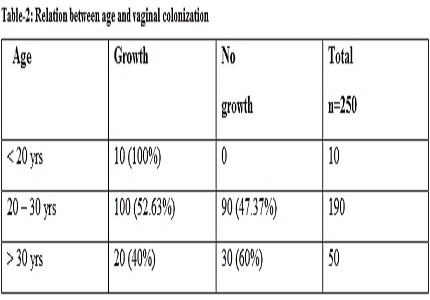Pattern of maternal vaginal flora in labor and its effect on the newborn
Abstract
Background: Neonatal sepsis is the most important cause of morbidity and mortality in developing countries. Early onset sepsis is attributed to abnormal bacterial colonization of the maternal urogenital tract which leads to either an ascending but silent amniotic fluid infection or symptomatic chorioamnionitis.
Aims & Objectives: 1. To study the pattern of maternal vaginal flora in labor. 2. To study the outcome in the neonate.
Methods: This study was conducted on 250 mothers in labor & their babies followed up till discharge in the departments of OBG & neonatology in a tertiary care medical college hospital, Deliveries by caesarean section were excluded.
Results: Out of 250 mothers 130 (52%) of them showed colonization. Out of the 130 babies born to colonised mothers, 50 (38.46%) showed features of sepsis, while only 10 (8.34%) born to non-colonised mothers had features of sepsis. This study showed a statistically significant association between features of sepsis in babies and maternal vaginal colonization. Of the 60 babies with suspected sepsis, 40 had positive blood culture which is the gold standard investigation for sepsis. All of these culture positive babies i.e all 40(100%) had maternal colonization with a statistically significant association.
Conclusion: This study shows that maternal vaginal colonisation has significant association with neonatal sepsis. Hence, finding the organism in the maternal vaginal flora and treating it as per sensitivity might result less cases of neonatal sepsis.
Downloads
References
2. Child Health Research. Project special report: Reducing perinatal and neonatal mortality, report of a meeting. Baltimore, Maryland. 1999; 6-12.
3. Leal YA, Nemegyei JA, Velázquez JR, et al. Risk factors and prognosis for neonatal sepsis in south eastern Mexico. BMC Pregnancy Childbirth 2012; 12: 48. [PubMed]
4. Yoon BH, Romero R, Moon JB, Shim SS, Kim M, Kim G, Jun JK. Clinical significance of intra-amniotic inflammation in patients with preterm labor and intact membranes. Am J Obstet Gynecol. 2001 Nov;185(5):1130-6. [PubMed]
5. A Dwi Bahagia Febriani, Andi Handriyati, Ema Alasiry, Dasril Daud. The correlation between the mothers vaginal bacterial colonization and incidence of early onset neonatal sepsis. CurrPediatr Res 2017; 21 (1): 105-111.
6. Klein J, Marcy M. Bacterial sepsis and meningitis. In Remington J, Klein J eds. Infectious Diseases of the Fetus and Newborn Infant, Ed 4. Philadelphia, WB Saunders, 1995; 835-890.
7. Squire E, Favara B, Todd J. Diagnosis of neonatalbacterial infection: hematologic and pathologicfindings in fatal and nonfatalcases.Pediatrics. 1979 Jul;64(1):60-4.
8. Liu L, Johnson HL, Cousens S, Perin J, Scott S, Lawn JE, Rudan I, Campbell H, Cibulskis R, Li M, Mathers C, Black RE; Child Health Epidemiology Reference Group of WHO and UNICEF. Global, regional, and national causes of child mortality: an updated systematic analysis for 2010 with time trends since 2000. Lancet. 2012 Jun 9;379(9832):2151-61. doi: 10.1016/S0140-6736(12)60560-1. Epub 2012 May 11. [PubMed]
9. Thaver D, Zaidi AK. Burden of neonatalinfections in developing countries: a review of evidence from community-basedstudies. PediatrInfectDis J. 2009 Jan;28(1Suppl):S3-9. doi: 10.1097/INF.0b013e3181958755.
10. Basavaraj MK, Bhat BV, Harish BN, et al. Maternal genital bacteria and surface colonization in early neonatal sepsis. Indian J Paediatrics 2006; 73: 29-32.
11. Seale AC, Blencowe H, Manu AA, et al. Estimates of possible severe bacterial infection in neonates in sub-Saharan Africa, south Asia and Latin America for 2012: A systematic review and meta-analysis. Lancet Infect Dis. 2014 Aug;14(8):731-741. [PubMed]
12. Hall SL, Hall RT, Barnes WG. Relationship of maternal to neonatal colonization with coagulase-negative staphylococci. Am J Perinatal. 1990; 7(4): 384-8
13. Vidya Ayengar, Madhulika, Vani SN. Neonatal sepsis due to vertical transmission from maternal genital tract. Indian J Pediatric. 1991; 58(5) 661-664. [PubMed]
14. Stoll Barbara J, Schuchat Anne. Maternal carriage of group B streptococci in developing countries. The Pediatric Infectious Disease Journal. 1998; 17(6): 499-503
15. Habeebullah S, Vishnu Bhat B, Basavaraj Kerur M, Harish BN. Maternal genital bacteria and surface colonization in early neonatal sepsis. Indian J Pediatr. 2006; 73(1): 29-32.
16. Beargie R, Lynd P, Tucker E, Duhring J. Perinatal infection and vaginal flora. Am J Obstet Gynecol. 1975 May 1;122(1):31-3.
17. Singh M, Deorari AK. Pneumonias in newborn babies. Indian J Pediatr. 1995 May-Jun;62(3):293-306. [PubMed]
18.Vikas Gautam, Pallab Ray, Anil Narang. Blood culture confirmed bacterial sepsis in neonates in a north Indian tertiary care center: Changes over the last decade. Jpn. J. Infect.Dis. 2009; 62(1):46-50.
19. E. S.Shinwell, Y. Matrai-Kovalskis, D. Greenberg, D. Fraser. Positive blood cultures for coagulase-negative staphylococci in neonates: Does highly selective vancomycin usage affect outcome? Infection. 1998; 26(2): 85-92.
20. Bhat BV, Pandey KK, Raghavan M, Kanugo R. Bacteriological profile of blood culture isolation from neonates. Indian Journal of Maternal and Child Health. 1994 Oct-Dec; 5(4): 114-6.
21. Habeebullah S, Vishnu Bhat B, Basavaraj Kerur M, Harish BN. Maternal genital bacteria and surface colonization in early neonatal sepsis. Indian J Pediatr. 2006; 73(1): 29-32.
22. Chan GJ, Baqui AH, Modak JK, Murillo-Chaves A, Mahmud AA, Boyd TK, Black RE, Saha SK. Early-onset neonatal sepsis in Dhaka, Bangladesh: riskassociated with maternalbacterial colonisation and chorioamnionitis. Trop Med Int Health. 2013 Sep;18(9):1057-1064. doi: 10.1111/tmi.12150. Epub 2013 Jul 4. [PubMed]
23. Marijane A. Krohn, SoeSoe Thwin, Lorna K. Rabe. Vaginal colonization by Escherichia coli as a risk factor for very low birth weight deliveries and other perinatal complications. The Journal of Infectious Diseases. 1997; 175(3): 606-610.

Copyright (c) 2017 Author (s). Published by Siddharth Health Research and Social Welfare Society

This work is licensed under a Creative Commons Attribution 4.0 International License.


 OAI - Open Archives Initiative
OAI - Open Archives Initiative


